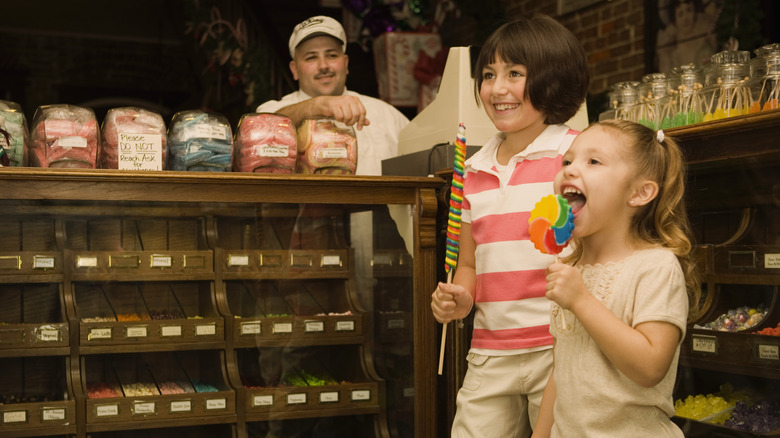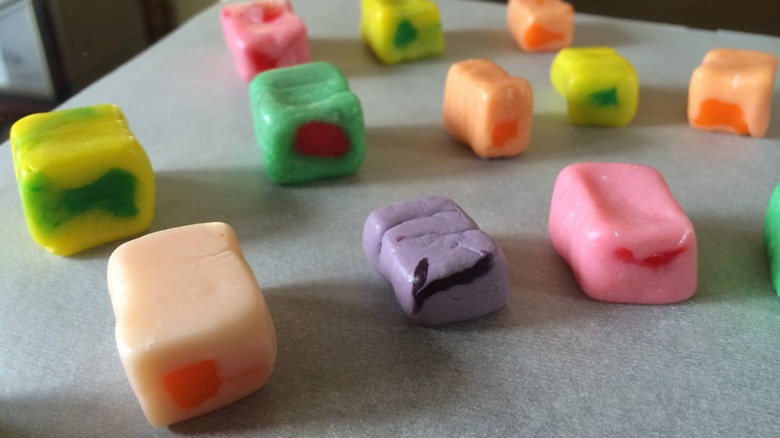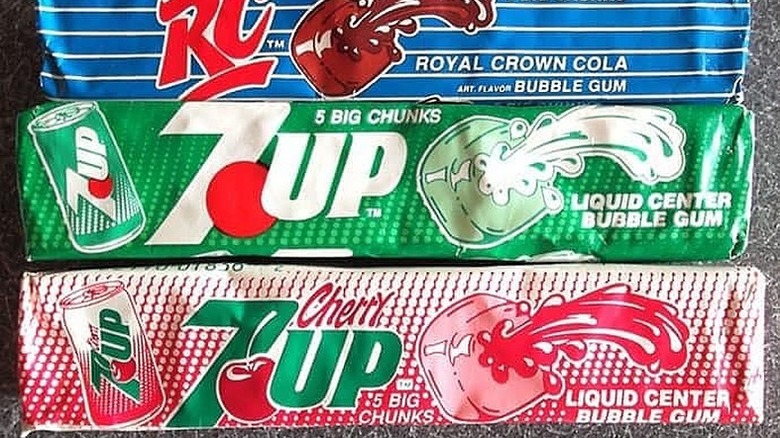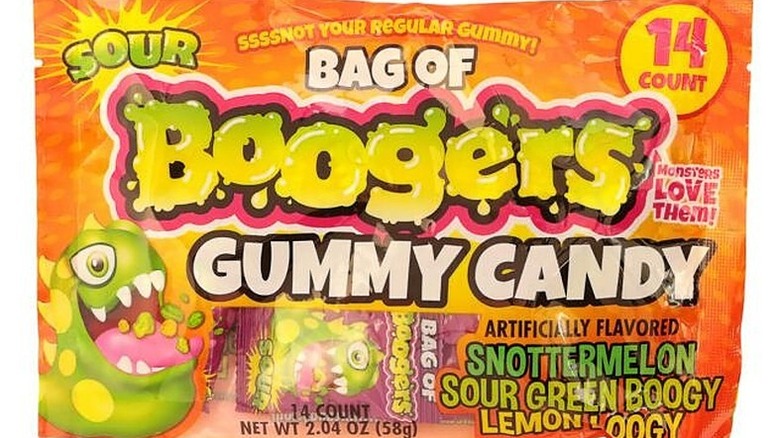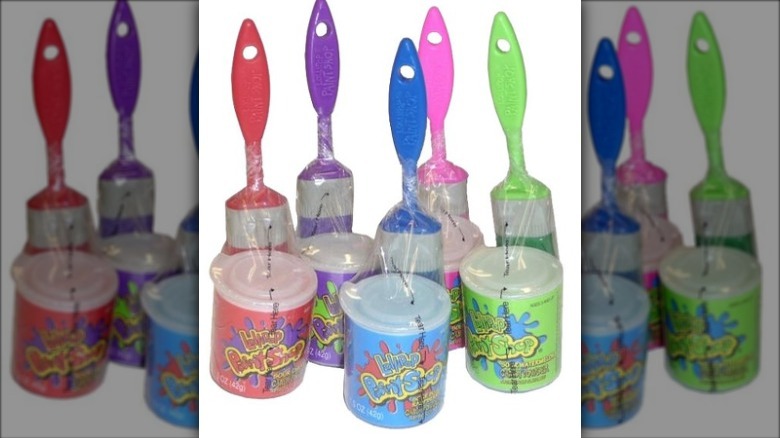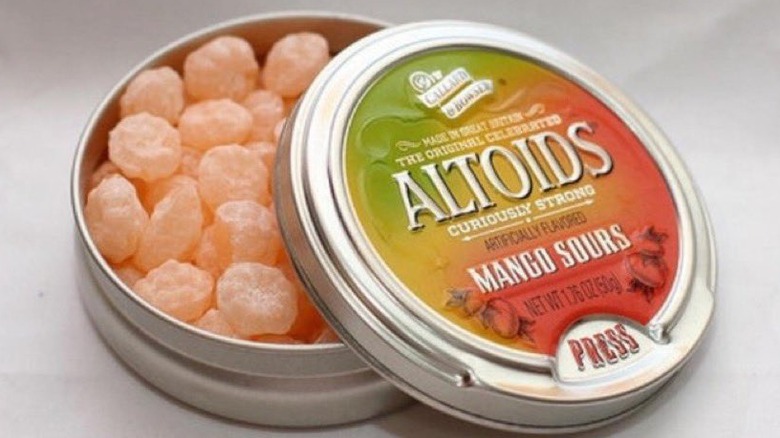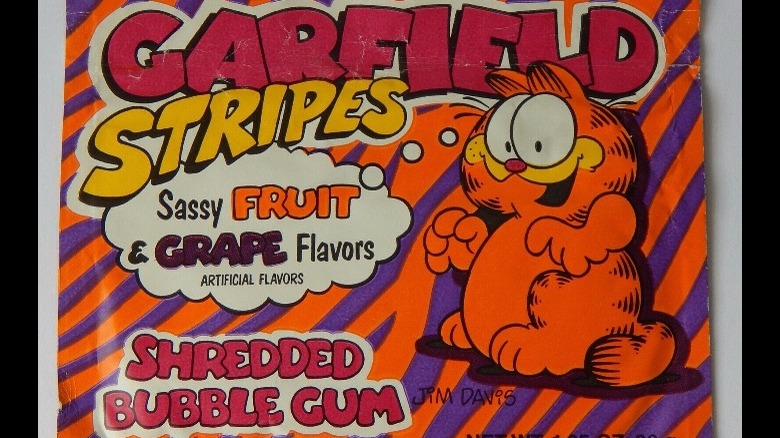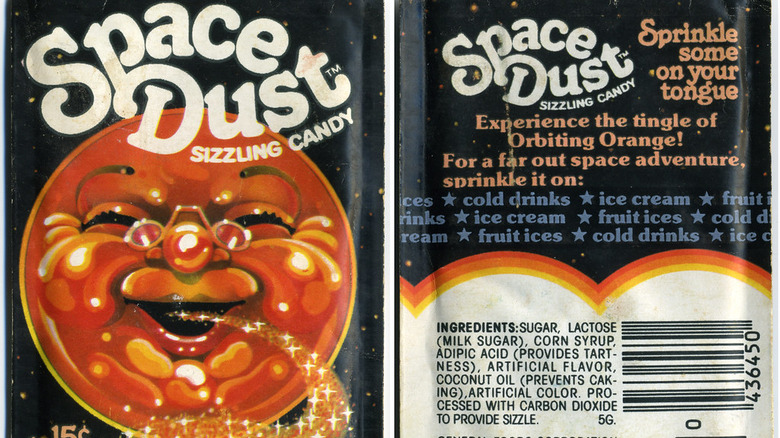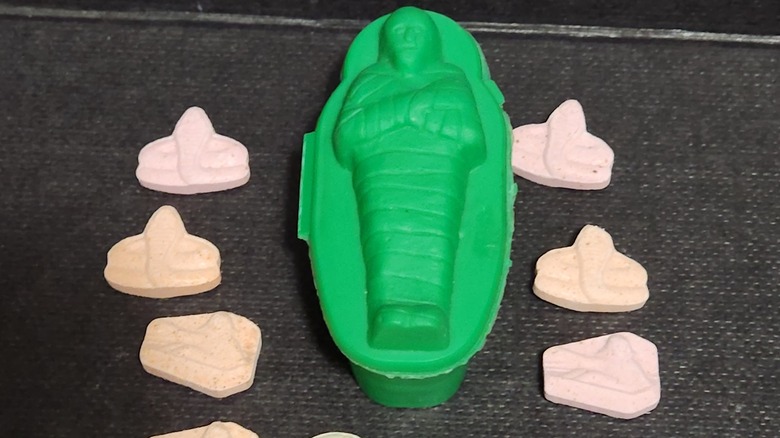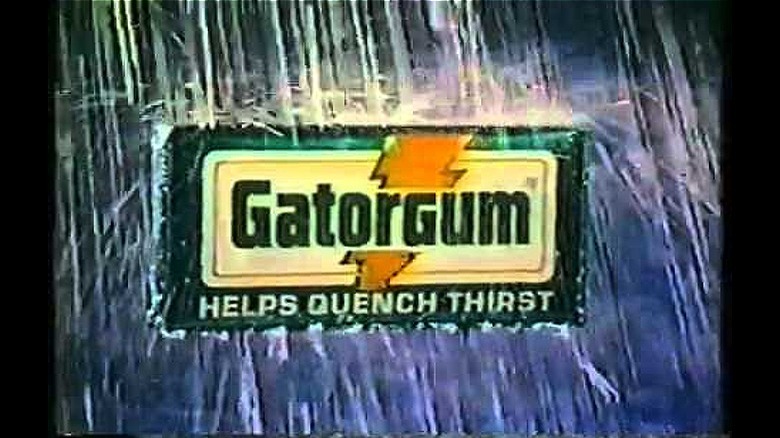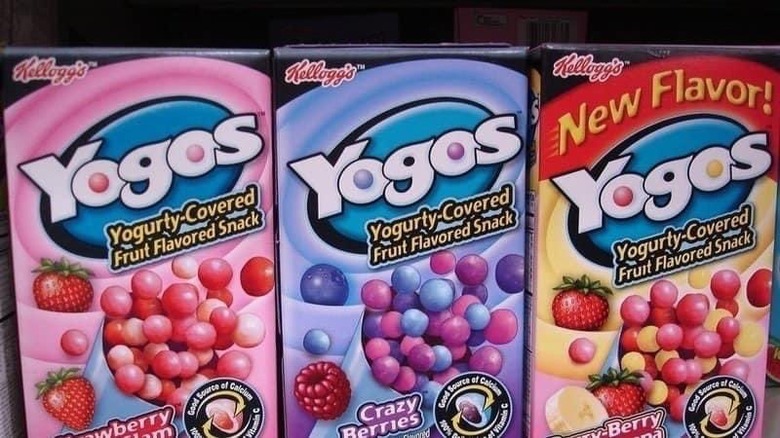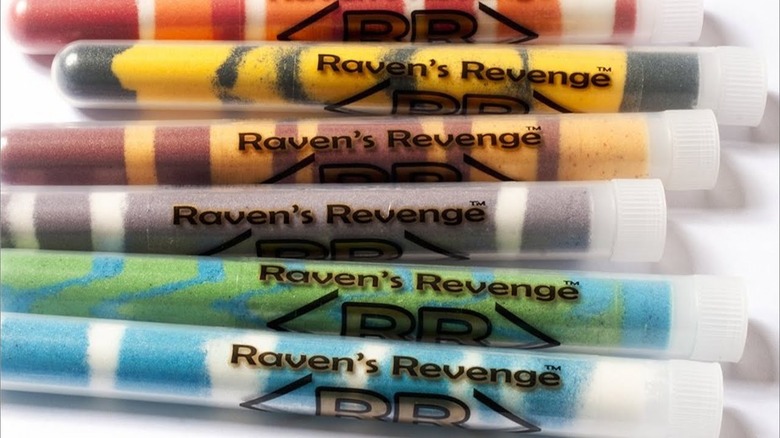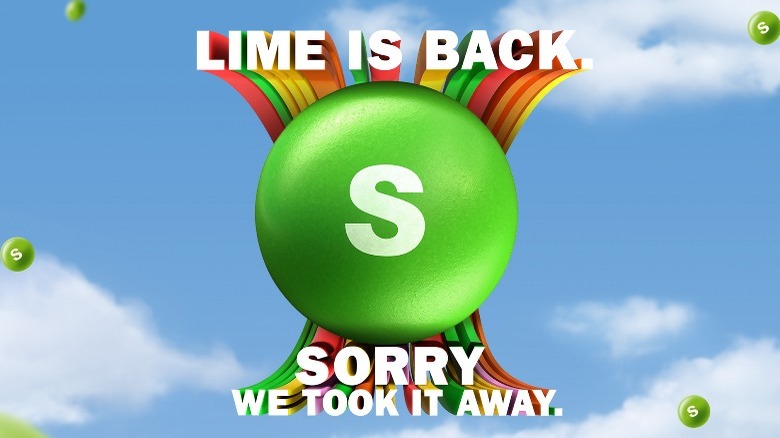The Reason These Fruity Candies Were Discontinued
Fruit and sugar have been a match made in heaven since candy first appeared at least 5,000 years ago (via Los Angeles Times). Dating back to ancient India, people processed the native sugarcane plant into lumps similar to modern-day rock candy or melted it into a syrup to use as a coating for dried fruits.
Since then, countless varieties of fruity candies have risen to the heights of fame, only to later fall into obscurity. For every seemingly eternal candy, there are thousands of products that have disappeared from store shelves.
Some sweets brought about their own demise, while others were unfairly ripped from store shelves and continue to be sorely missed. Some came and went with an air of mystery, leaving fans to wonder if their memory was just a sugary dream.
Gone but not forgotten, the fruity candies of the past live on in our minds. From the curious case of the disappearing Bonkers to the lime Skittles comeback story for the ages, here are the reasons these fruity candies were discontinued.
Bonkers
In the mid-1980s, Nabisco launched a chewy, tangy candy that can best be described as a cross between a Starburst and a Gusher (via Snack History). Each chewy vanilla square was filled with a different fruity filling like lemon-lime, grape, cherry, orange, or watermelon.
More so than the candy itself, Bonkers gained almost instant fame thanks to an ad campaign in which people eating bonkers candy were walloped with giant strawberries, oranges, and other fruit. Hence the slogan "Bonkers! Bonks you out!"
The mildly threatening campaign was a hit, so to speak. So was the follow-up ad in which a straight-faced Southern woman stares unblinkingly into the camera while her family members are pummeled by enormous fruit, as she says in a deadpan voice, "My son thought Bonkers was gum. He knows its candy now." (via YouTube).
The fruity candy gradually lost its ability to draw in customers when the commercials stopped running. Sales declined and Bonkers became harder to find. By the 1990s, Nabisco discontinued production. The discontinued candy was acquired by Leaf Brands, which promised fans that a reboot was coming in 2015. 2015 came and went without a single person getting bonked out by Bonkers.
In 2018, Leaf announced that the iconic '80s candy was set to hit shelves by that summer with a new vegan recipe (via PR Newswire). 2018 came and went and fans still don't have any new Bonkers or updates on when the reboot will happen (via Nothing But Nostalgia).
7Up Gum
While fans are eager to see some of their favorite '80s candies return, few people miss the short-lived era of the soda gum. Also from the '80s, 7Up gum is exactly what it sounds like, except much worse. In what was billed at the time as a genius marketing idea, a Wrigley's subsidiary started filling chunks of bubble gum with concentrated 7Up syrup (via Chicago Tribune).
The result was an unpleasant burst of concentrated syrup that bore almost no resemblance to the soda it was supposed to taste like. One blogger who recalled trying the soda gum back in the '80s described it as "molten gunk" that tasted like "melted confectioner sugar" (via The Internet Is In America).
Other flavors in the lineup included Dr. Pepper, A&W Root Beer, and Cherry 7Up, with big plans to land a licensing deal with Coca-Cola or Pepsi. Those collaborations didn't pan out and the line of soda gums disappeared soon after they launched.
Boogers
Adults might think eating boogers is gross, but what do they know? The 1988 launch of Boogers, a gummy candy that came in a variety of flavors like lumpy lemon and goopy grape, ended up being incredibly successful for its manufacturer, New Jersey-based Confex, Inc. (via Time Magazine). Sales reached $2 million (a value of approximately $4.9 million in today's currency) in its first year on the market. At $0.40 per bag, that's five million bags of boogers sold.
According to The New York Times, the bag came with a mix of booger shades including green and red. But the candy achieved peak strangeness with its marketing campaign, which featured a 6-foot tall actor in a green, slimy booger costume known as the Boogerman (via South Florida Sun-Sentinel). The Boogerman traveled the country handing out bags of boogers to delighted children and disconcerted parents.
Then-President of Confex, John Sullivan, told The New York Times that kids liked the candy so much because it was "a way of shocking their parents and asserting their independence." While parents weren't quite as thrilled with the concept, their disapproval only helped sales. "The more the parents scream, the more the kids want the candy," Sullivan told Time Magazine.
We don't know exactly when Boogers were discontinued, but the trademark expired without being renewed in 1998, suggesting it fell out of production sometime in the mid-1990s (via Trademarkia). However, you may still be able to snag a bag of sour Boogers by Flix Candy.
Lollipop Paint Shop
Speaking of candy shaped like something you probably shouldn't eat, meet the '90s treat that made licking paint fun. Lollipop Paint Shop came out at a time when candy makers seemed obsessed with turning just about any ordinary object into candy. We had boxes of Band-Aids that were actually bubble gum, a neon plastic beeper that was also just bubble gum, and a small tub of laundry detergent that was, again, just bubble gum.
In keeping with this '90s-era obsession, Lollipop Paint Shop was a tub of powdered candy with a candy paintbrush. It was basically Fun Dip except kids had to dip a paintbrush into a paint can, effectively dyeing their tongues fun colors in the process (via Chicago Tribune).
Parents weren't thrilled with the idea of encouraging kids to lick paint, which led to a lag in sales that eventually resulted in the candy being discontinued a few years later (via USA Today).
Altoids Sours
This fruity and sour twist on the classic breath mint was a divisive candy during its time in the early 2000s. In keeping with the Altoid slogan of being "curiously strong," the sour coating was, admittedly, a little sourer than it probably needed to be. You couldn't really taste anything past the mouth-puckering sensation until the coating was gone. Then, it was just a sweet hard candy.
Still, devoted fans loved working through the almost unbearable sour coating to get to the fruity candy beneath. But haters thought it was way too sour and, more to the point, failed to serve as a breath freshener which is what original Altoids are supposed to be.
Unfortunately, the devoted fans were far outnumbered and sales of Altoid Sours lagged. A Mars company representative told Bustle that the product was discontinued in 2010 because the demand was too low to continue manufacturing it.
Garfield Stripes Gum
The Garfield comic strip first appeared in national newspapers in late 1977 and became an overnight success that has since grown into a $1 billion per year merchandising empire at its peak (via Licensing International). One of the first merchandising deals was with Amurol-Wrigley and consisted of a pouch of shredded bubble gum in "sassy fruit and grape flavors" called Garfield Stripes.
This came at a time when pouches of shredded bubble gum were all the rage. In the same vein as candy cigarettes, shredded gum pouches were designed to look like pouches of chew tobacco. Unlike candy cigarettes which were banned by the U.S. Food and Drug Administration in 2009, shredded gum pouches are still going strong.
Discontinued in 1982, the gum likely struggled to compete against Big League Chew, which continues to dominate the shredded bubble gum market despite many unsuccessful attempts to dethrone it (via Mental Floss).
Space Dust
Later renamed Cosmic Candy, Space Dust is essentially what you would get if you ground up Pop Rocks into a powder. General Foods brought both versions of the revolutionary carbonated candy to the market around the same time in the mid-1970s (via Rumor in the Marketplace). It was a game changer that marveled kids and terrified parents.
The candy fell victim to rumors that it could explode stomachs, most notably that Little Mikey from then-popular LIFE cereal commercials had died from eating Pop Rocks and chasing it with soda. This rumor was surprisingly persistent, despite the fact that the actor who played Little Mikey was very much not dead (via Snopes).
While a nationwide advertising and letter-writing campaign helped calm fears that the candy was blowing up children's stomachs, Space Dust suffered a second scandal that would ultimately spell its doom. According to worried parents, the original name, Space Dust, sounded too much like Angel Dust, the street name for PCP (via Yahoo! Life). The fact that it was a small packet of powder didn't help, either. Some parents thought it would encourage their kids to turn to real drugs.
The switch to the new name "Cosmic Candy" was an attempt to separate the candy from these drug associations. But, between the rumors of exploding stomachs and illicit drugs, the powder version of Pop Rocks was unable to sustain sales and was eventually discontinued.
Munchy Mummies
Developed by Topps Chewing Gum in the 1970s, Munchy Mummies were a delightfully macabre candy concept. A small plastic sarcophagus housed an assortment of crunchy candies that resembled Pez except that they were shaped like skulls, corpses, and various animals (via Candy Wrapper Museum).
This was for sale at the same time as Drac-Snax, also from Topps. The two products were essentially the same chalky candy but in different packaging. Drac-Snax came in a pouch and featured shapes like a man missing a head and a gravestone (via Candy Wrapper Museum). The pouch wasn't nearly as cool as the sarcophagus though.
Despite superior packaging, Munchy Mummies don't seem to have enjoyed much commercial success and the candy disappeared from store shelves by the '80s (via Grubbits). Perhaps its demise was related to the fact that the mummy has always struggled to step out of the shadow of more popular movie monsters like Dracula and Frankenstein (via Escapist Magazine).
GatorGum
GatorGum was another '80s attempt to sell gum by using an already well-known brand, in this case, the popular sports drink Gatorade. While the concept was definitely better executed than the soda concentrate-filled 7Up gum, it still failed to win over enough fans.
Most consumers found it too sour or just generally unpleasant. Even fans of the product described the taste as "salty and sour" (via Fourth Grade Nothing). Since most people aren't really looking for those features in their chewing gum, the product only ever held appeal for a niche audience.
Still, the gum enjoyed about a 10-year run spanning most of the '80s before the licensing deal between the manufacturer and Gatorade expired (via U-Select-It). The sports drink brand refused to renew the license and the gum disappeared from shelves soon after. Select fans still miss the unique flavor but it seems unlikely to make a comeback.
Yogos
The story of Yogos is a curious one. The small "yogurty-covered" bits sold by Kellogg's in the early 2000s were an immediate crowd-pleaser. A successful launch in 2005 continued positively with strong sales in the years that followed (via Kellogg's).
Despite its enduring popularity, Yogos and its many spin-offs disappeared from store shelves in 2010 — just five years after launching. The sudden decision to discontinue a popular fruity candy has left fans puzzled ever since.
One theory is that they weren't especially nutritious. Kellogg's was under intense scrutiny at the time from federal agencies for marketing sugary and generally unhealthy food products to children (via The New York Times). Yogos' packaging billed the bits of sugar and corn flour as a good source of calcium and vitamin C. Kellogg's may have pulled the product line in response to criticism about these advertising practices.
Another theory is that Yogos were just too expensive to produce and ship because the yogurt-like coating was prone to spoiling. The high cost of production ate into profit margins, so the theory goes, and Kellogg's decided it wasn't worth the trouble to keep making them (via Candy Turf).
Raven's Revenge
Another mysterious disappearance, Raven's Revenge almost feels like an urban legend for those who remember it. The late '90s candy was a sweet and sour powder packaged in what looked like a test tube from a lab. A range of different flavors was sold with excitingly edgy names like "Anarchy" or "School Sucks," which told you nothing about the actual flavor but sounded irresistibly cool to kids across America.
To add to the intrigue surrounding Raven's Revenge, its manufacturer spent exactly $0 on advertising (via Los Angeles Times). With no marketing whatsoever, Raven's Revenge swept through the nation solely thanks to fans raving about the sweet treat. Elementary and middle school kids in the know got the candy from other kids through what developed into a strange black market run by children.
Why kids were treating Raven's Revenge like an illicit drug you had to exchange and consume secretly is unclear. Schools hadn't banned it. Parents were largely unaware or unconcerned by its existence. Kids at the time seem to have just collectively decided that Raven's Revenge was a great secret that needed to be kept hidden from grown-ups at all costs. As mysteriously as it emerged, Raven's Revenge eventually disappeared, leaving little trace that it ever existed at all.
The Lime Skittle
When Skittles debuted in the United States in 1979, the bag came with a mix of grape, strawberry, orange, lemon, and lime. This classic cast endured unchanged for decades. Other flavors were developed but they were packaged in their own separate collections.
That is until 2013, when Mars, the company that manufactures the candy, decided to cash in on the green apple craze sweeping the nation at the time. Mars swapped the flavor of the green Skittle from lime to green apple, a marketing decision the company would soon regret (via Slate). After the swap, one heartbroken fan at the time declared, "The perfection that was the Original Fruits Skittles is now gone." (via CandyBlog). Needless to say, folks were not happy.
The outrage didn't go away, either. For years, fans made their disappointment known, and in 2021, Skittles released a limited edition all-lime bag in an attempt to make amends. When that wasn't enough, the company made the decision to permanently change the green Skittle in the original bag back to lime.
Mars Wrigley Senior Brand Manager, Fernando Rodrigues, announced the return of the lime Skittle later that year, saying, "The joy of Lime can't be denied anymore. It is back. This time for good," (via PR Newswire). The next time you're disappointed about a discontinued candy, take a page out of the Skittles fans' playbook and complain relentlessly to pressure the manufacturer into bringing it back.
